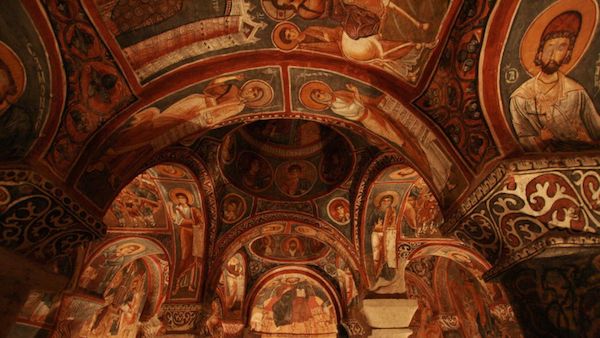The French explorer Paul Loucas was sent to the Middle East by Louis XIV at the beginning of the 18th century AD. On his way to Kayseri, he was surprised by the sight of the volcanic Korama valley where people had houses carved in the shape of a cone out of the rocks. At first, what he had seen were the tombs of a lost civilization, but he realized that these were the actual houses inhabited by a people in the past. He spread the news back to his country and many researchers visited the so-called Goreme Valley and explored the houses, monasteries and churches in the area. Among the stone structures, they found a chapel dating back to the 7th century AD and a lot of frescoes. Goreme was an important area during the early Byzantine era and the churches and monasteries in the valley are open to the public today as an open-air museum. Some of them have been restored, while it is believed that there are still churches that have not yet been discovered.
The Dark Church
The fact that it is dimly lit is the reason for naming it the dark church. It was originally conceived as a monastery, consisting of an upper level for the monks’ dwellings and a lower level that housed the church. There are some stairs leading up to an arched doorway that gives access to the church. A small window in the narthex was the only opening where light enters the church, before the front of the building collapsed. The frescoes in the Dark Church are impressively vivid in order to be visible in the dim light. They depict scenes from the Ascension, the Crucifixion, the Resurrection and Passion of Jesus, the betrayal of Judas, the trial by Pontius Pilate and others.
The Tokali Church
This is the largest church and one of the best preserved, consisting of two churches that were built in different periods. The life of Jesus Christ (Annunciation, Baptism, entry into Jerusalem, the miracle at Cana, the resurrection of Lazarus) is depicted in the church’s frescoes, where the most frequent colors are green, blue, red and brown. The entrance to the church is called Old Tokali. Its architectural style is Syrian and Cappadocian, but there is also a Greco-Roman style arch over the church’s columns.
The Carikli Church
Built in the 11th century AD, this consists of two levels and its name (meaning sandal) derives from the shapes of footprints in front of the entrance. It is a barrel-vaulted church with a dome. The lower level consists of three rooms. The church frescoes depict Jesus on his throne with the Virgin Mary and St. John on either side, the resurrection of Lazarus and angels by Jesus’ tomb.
The Elmali Church
Named after the apple trees around the church (Elmali means “with apples”) it has a large window that allows light to enter the church. The main hall has collapsed and so the church is accessed through a tunnel. The wall painting is in harmony with the structure, depicting the Baptism of Jesus, the crucifixion and resurrection, the writers of the Bible, Jesus Christ on his throne, the Virgin Mary, and St. John the Baptist.
The Yilanali Church
It was built in the 11th century and has a rectangular shape with a barrel vault. There is a doorway with two columns and an arch behind the balcony. Paintings depicting St. Basil, St. Theodora, St. George, St. Thomas and St. Onofrio adorn the apse of the church.
St. Catherine’s Chapel
St. Catherine’s Chapel is located between the churches and Karanlik Carikli. It was built by a woman called Anna and has a central dome. There are nine tombs on the floor of the narthex and two graves in niches in the walls. The paintings depict St. George on his horse, St. Basil, St. Gregory, St. John the Baptist, St. Theodora and St. Catherine.
Church of St. Barbara
It dates back to the 11th century AD and possibly the paintings on its walls date from various periods. A crown door with a small courtyard adorned the entrance, but a large part of it has been destroyed. Red symbols were drawn on the walls and some of them date from the iconoclastic period. We can see Christ Pantrocratore, St. George on his horse slaying a dragon, St. Theodora and St. Barbara on the altar. Possibly this temple was used for funerals.
The Monastery of the Nun
A six-storey high stone is located on the left side of Goreme’s open-air museum and is known as the Nun’s Monastery. There is a kitchen, a refectory and some bedrooms on the first two floors. The church is located on the third floor and can be accessed through a tunnel. In case of danger, the tunnels were closed off with stones from a turned screw.
Cavusin
Located 2.5 km from the Goreme-Avanos road, it consists of houses around a mountain rock that has been confused by erosion and earthquakes. You can see the dome-shaped structures, buildings used for prayer, and caves inhabited by monks between the houses. The great basilica of St. John’s Monastery is one of the oldest buildings in the Cappadocia region and was carved into the top of the rock, although it seems to have been hidden in this mass.
Church of Nicephoros Focas
It is located 2.5 km from Göreme and was built to honor the emperor Nicephoros Focas in the middle of the 10th century AD. There is only one nave and the narthex of the church has been destroyed. Portraits of the emperor and his family can be seen in the main hall of the church, as well as paintings inspired by the Bible and other Christian themes.


0 Comment